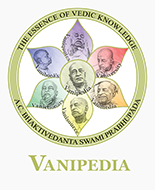 #div class="mw-parser-output"#
#h4##span class="mw-headline" id="TEXT_137"#TEXT 137#/span##/h4#
#div class="verse"#
#dl##dd#rāya kahe,--"prarocanādi kaha dekhi, śuni?"#/dd#
#dd#rūpa kahe,--"mahāprabhura śravaṇecchā jāni"#/dd##/dl#
#/div#
#h4##span class="mw-headline" id="SYNONYMS"#SYNONYMS#/span##/h4#
#div class="synonyms"#
rāya kahe — Śrīla Rāmānanda Rāya says; prarocanādi kaha — please recite the prarocanā; dekhi — I shall see; śuni — and hear; rūpa kahe — Śrīla Rūpa Gosāñi replies; mahāprabhura — of Śrī Caitanya Mahāprabhu; śravaṇa-icchā — desired to hear; jāni — I think.
#/div#
#h4##span class="mw-headline" id="TRANSLATION"#TRANSLATION#/span##/h4#
#div class="translation"#
Rāmānanda Rāya said, "Please recite the prarocanā portion so that I may hear and examine it." Śrī Rūpa replied, "I think that the desire to hear of Śrī Caitanya Mahāprabhu is prarocanā.
#/div#
#h4##span class="mw-headline" id="PURPORT"#PURPORT#/span##/h4#
#div class="purport"#
The method of inducing the audience to become more and more eager to hear by praising the time and place, the hero and the audience is called prarocanā. This is the statement regarding prarocanā in the Nāṭaka-candrikā:
#$p#deśa-kāla-kathā-vastu-
#dl##dd#sabhyādīnāṁ praśaṁsayā#/dd#
#dd#śrotṝṇām unmukhī-kāraḥ#/dd#
#dd#kathiteyaṁ prarocanā#/dd##/dl#
Similarly the Sāhitya-darpaṇa (6.286) says:
#dl##dd#tasyāḥ prarocanā vīthī#/dd#
#dd#tathā prahasanā-mukhe#/dd##/dl#
aṅgānyatronmukhī-kāraḥ
#dl##dd#praśaṁsātaḥ prarocanā#/dd##/dl#
Any literature presented in Sanskrit must follow the rules and regulations mentioned in the authoritative reference books. The technical inquiries by Śrīla Rāmānanda Rāya and the replies of Śrīla Rūpa Gosvāmī indicate that both of them were expert and fully conversant with the techniques of writing drama.
#/div#
#/div# #div class="mw-parser-output"#
#h4##span class="mw-headline" id="TEXT_137"#TEXT 137#/span##/h4#
#div class="verse"#
#dl##dd#rāya kahe,--"prarocanādi kaha dekhi, śuni?"#/dd#
#dd#rūpa kahe,--"mahāprabhura śravaṇecchā jāni"#/dd##/dl#
#/div#
#h4##span class="mw-headline" id="SYNONYMS"#SYNONYMS#/span##/h4#
#div class="synonyms"#
rāya kahe — Śrīla Rāmānanda Rāya says; prarocanādi kaha — please recite the prarocanā; dekhi — I shall see; śuni — and hear; rūpa kahe — Śrīla Rūpa Gosāñi replies; mahāprabhura — of Śrī Caitanya Mahāprabhu; śravaṇa-icchā — desired to hear; jāni — I think.
#/div#
#h4##span class="mw-headline" id="TRANSLATION"#TRANSLATION#/span##/h4#
#div class="translation"#
Rāmānanda Rāya said, "Please recite the prarocanā portion so that I may hear and examine it." Śrī Rūpa replied, "I think that the desire to hear of Śrī Caitanya Mahāprabhu is prarocanā.
#/div#
#h4##span class="mw-headline" id="PURPORT"#PURPORT#/span##/h4#
#div class="purport"#
The method of inducing the audience to become more and more eager to hear by praising the time and place, the hero and the audience is called prarocanā. This is the statement regarding prarocanā in the Nāṭaka-candrikā:
#$p#deśa-kāla-kathā-vastu-
#dl##dd#sabhyādīnāṁ praśaṁsayā#/dd#
#dd#śrotṝṇām unmukhī-kāraḥ#/dd#
#dd#kathiteyaṁ prarocanā#/dd##/dl#
Similarly the Sāhitya-darpaṇa (6.286) says:
#dl##dd#tasyāḥ prarocanā vīthī#/dd#
#dd#tathā prahasanā-mukhe#/dd##/dl#
aṅgānyatronmukhī-kāraḥ
#dl##dd#praśaṁsātaḥ prarocanā#/dd##/dl#
Any literature presented in Sanskrit must follow the rules and regulations mentioned in the authoritative reference books. The technical inquiries by Śrīla Rāmānanda Rāya and the replies of Śrīla Rūpa Gosvāmī indicate that both of them were expert and fully conversant with the techniques of writing drama.
#/div#
#/div# |
 #div class="mw-parser-output"#
#h4##span class="mw-headline" id="TEXT_137"#TEXT 137#/span##/h4#
#div class="verse"#
#dl##dd#rāya kahe, — “prarocanādi kaha dekhi, śuni?”#/dd#
#dd#rūpa kahe, — “mahāprabhura śravaṇecchā jāni“#/dd##/dl#
#/div#
#h4##span class="mw-headline" id="SYNONYMS"#SYNONYMS#/span##/h4#
#div class="synonyms"#
rāya kahe — Śrīla Rāmānanda Rāya says; prarocanādi kaha — please recite the prarocanā; dekhi — I shall see; śuni — and hear; rūpa kahe — Śrīla Rūpa Gosāñi replies; mahāprabhura — of Śrī Caitanya Mahāprabhu; śravaṇa-icchā — desire to hear; jāni — I think.
#/div#
#h4##span class="mw-headline" id="TRANSLATION"#TRANSLATION#/span##/h4#
#div class="translation"#
Rāmānanda Rāya said, "Please recite the prarocanā portion so that I may hear and examine it."
Śrī Rūpa replied, "I think that Śrī Caitanya Mahāprabhu’s desire to hear is prarocanā.
#/div#
#h4##span class="mw-headline" id="PURPORT"#PURPORT#/span##/h4#
#div class="purport"#
The method of inducing the audience to become more and more eager to hear by praising the time and place, the hero and the audience is called prarocanā. This is the statement regarding prarocanā in the Nāṭaka-candrikā:
#dl##dd#deśa-kāla-kathā-vastu-sabhyādīnāṁ praśaṁsayā#/dd#
#dd#śrotṟṇām unmukhī-kāraḥ kathiteyaṁ prarocanā#/dd##/dl#
Similarly, the Sāhitya-darpaṇa (6.286) says:
#dl##dd#tasyāḥ prarocanā vīthī tathā prahasanā-mukhe#/dd#
#dd#aṅgānyatronmukhī-kāraḥ praśaṁsātaḥ prarocanā#/dd##/dl#
Any literature presented in Sanskrit must follow the rules and regulations mentioned in the authoritative reference books. The technical inquiries by Śrīla Rāmānanda Rāya and the replies of Śrīla Rūpa Gosvāmī indicate that both of them were expert and fully conversant with the techniques of writing drama.
#/div#
#/div# #div class="mw-parser-output"#
#h4##span class="mw-headline" id="TEXT_137"#TEXT 137#/span##/h4#
#div class="verse"#
#dl##dd#rāya kahe, — “prarocanādi kaha dekhi, śuni?”#/dd#
#dd#rūpa kahe, — “mahāprabhura śravaṇecchā jāni“#/dd##/dl#
#/div#
#h4##span class="mw-headline" id="SYNONYMS"#SYNONYMS#/span##/h4#
#div class="synonyms"#
rāya kahe — Śrīla Rāmānanda Rāya says; prarocanādi kaha — please recite the prarocanā; dekhi — I shall see; śuni — and hear; rūpa kahe — Śrīla Rūpa Gosāñi replies; mahāprabhura — of Śrī Caitanya Mahāprabhu; śravaṇa-icchā — desire to hear; jāni — I think.
#/div#
#h4##span class="mw-headline" id="TRANSLATION"#TRANSLATION#/span##/h4#
#div class="translation"#
Rāmānanda Rāya said, "Please recite the prarocanā portion so that I may hear and examine it."
Śrī Rūpa replied, "I think that Śrī Caitanya Mahāprabhu’s desire to hear is prarocanā.
#/div#
#h4##span class="mw-headline" id="PURPORT"#PURPORT#/span##/h4#
#div class="purport"#
The method of inducing the audience to become more and more eager to hear by praising the time and place, the hero and the audience is called prarocanā. This is the statement regarding prarocanā in the Nāṭaka-candrikā:
#dl##dd#deśa-kāla-kathā-vastu-sabhyādīnāṁ praśaṁsayā#/dd#
#dd#śrotṟṇām unmukhī-kāraḥ kathiteyaṁ prarocanā#/dd##/dl#
Similarly, the Sāhitya-darpaṇa (6.286) says:
#dl##dd#tasyāḥ prarocanā vīthī tathā prahasanā-mukhe#/dd#
#dd#aṅgānyatronmukhī-kāraḥ praśaṁsātaḥ prarocanā#/dd##/dl#
Any literature presented in Sanskrit must follow the rules and regulations mentioned in the authoritative reference books. The technical inquiries by Śrīla Rāmānanda Rāya and the replies of Śrīla Rūpa Gosvāmī indicate that both of them were expert and fully conversant with the techniques of writing drama.
#/div#
#/div# |

 Compare previous verse
|
Compare next verse
Compare previous verse
|
Compare next verse 
